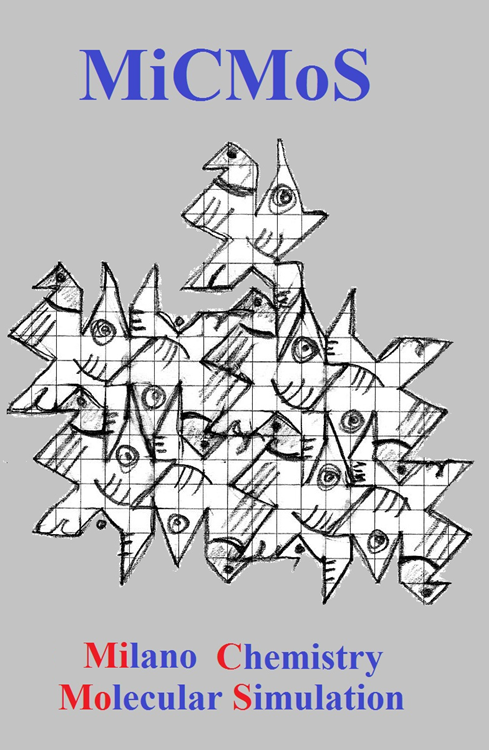 MiCMOS (Chemistry at Milano Molecular Simulation) is a set of Fortran computer programs for the simulation of the condensed states of small-molecule organic matter, using empirical potential energy schemes, ab initio-derived semiempirical energy calculation schemes, in a static approach analyzing only one point in phase space, or in an evolutionary approach for phase-space sampling using Monte Carlo (MC) and classical Molecular Dynamics (MD) techniques.
MiCMOS (Chemistry at Milano Molecular Simulation) is a set of Fortran computer programs for the simulation of the condensed states of small-molecule organic matter, using empirical potential energy schemes, ab initio-derived semiempirical energy calculation schemes, in a static approach analyzing only one point in phase space, or in an evolutionary approach for phase-space sampling using Monte Carlo (MC) and classical Molecular Dynamics (MD) techniques.
You can download here the users' manual.
Some Tutorials are available on this site to help new users getting acquainted with the program and I/O handling.
A library of ready-to-use Topologies for the simulation of various liquids and solids is also available.
MiCMoS is oriented toward the simulation of small organic molecules in condensed phase from a crystallographic viewpoint. At variance with other MC and MD softwares devoted to the simulation of biomolecules, it focuses on intermolecular interactions, solvation and molecule-molecule recognition.
MiCMoS evolves out of previouasly presented platforms, CLP-Pixel and CLPDyn, and like its predecessors is user-oriented with many opportunities or necessity for human intervention in the proceedings. See also http://www.angelogavezzotti.it/.
MiCMoS includes modules for:
- Retrieval of crystallographic information with standardization of hydrogen-atom positions;
- Calculation of lattice energies;
- Analysis of crystal packing, including statistical studies of interaction geometries;
- Molecule-molecule interaction energies;
- Simulation of bulk or cluster-like liquids with up to two chemical components, using either Monte Carlo (MC) or classical Molecular Dynamics (MD) methods;
- MC and MD simulations of bulk or cluster-like solids.
All programs run from a MS-Dos (Windows) or from any textual user interface environment (Unix-Linux machines). All input-output is numerical in text files and there are no pull-down menus or selection windows. There is no graphics module in the package, but interfacing to one of the many available graphics platforms is easy as structural results are displayed in a dat file format.
The whole MiCMoS package is available free of charge for academic and non-profit users under the conditions of the GNU general public license version 3.0 or later. To download the program, you should register here. You will be required to provide us with your name and a valid e-mail address (see also the privacy policy of the hosting website).
If you are already registered, please login and go to the download page.
If you use profitably MiCMoS modules in your work, please cite the following references, whatever appropriate:
A general survey of the MiCMoS features: A. Gavezzotti, L. Lo Presti and S. Rizzato, CrystEngComm, 2022,24, 922-930
Specific applications:
- PIXEL module (Pixel method): A. Gavezzotti, Mol. Phys. 2008, 106, 1473–1485
- Monte Carlo: A. Gavezzotti, New J. Chem. 2011, 35, 1360-1368; A. Gavezzotti, New J. Chem, 2013, 37, 2110-2119
- Molecular dynamics of liquids: A. Gavezzotti and L. Lo Presti, New J. Chem. 2019, 43, 2077–2084; L. Sironi, G. Macetti and L. Lo Presti, J. Mol. Liquids, 2024, 414, 126141.
- Molecular dynamics of solids: A. Gavezzotti and L. Lo Presti, J. Appl. Cryst. 2019, 52, 1253–1263; A. Gavezzotti, L. Lo Presti and S. Rizzato, CrystEngComm 2020, 22, 7350–7360
- Anisotropic pressure control: S. Rizzato, A. Gavezzotti and L. Lo Presti, Cryst. Growth Des. 2020, 20, 11, 7421–7428
- Kinetic bias algorithm to simulate aggregation phenomena: L. Lo Presti, S. Rizzato and A. Gavezzotti, Crystal Growth Des. 2022, 22, 1857-1866
- Molecular dynamics in confined space: L. Sironi, G. Macetti and L. Lo Presti, Phys. Chem. Chem. Phys., 2023,25, 28006-28019
- Molecular clusters and nanoscale inhomogeneities: Sironi, Macetti and Lo Presti, 2024, J. Mol. Liq., 414(B):126141
- Dynamic symmetries: Sironi, Macetti, Vacchini and Lo Presti, 2025, Struct. Chem. https://doi.org/10.1007/s11224-025-02483-w
